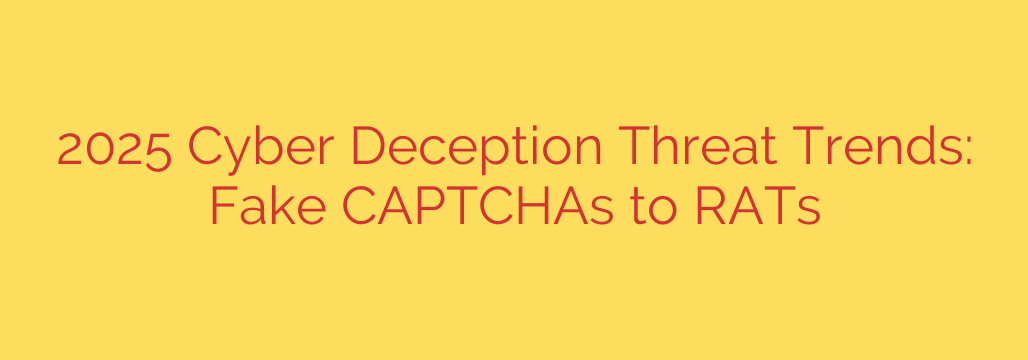
Beyond the Phish: How Fake CAPTCHAs and Advanced Deception Will Define 2025’s Cyber Threats
The digital world is built on a foundation of subtle checks and balances. One of the most common is the CAPTCHA—that familiar “I’m not a robot” checkbox or distorted text puzzle designed to separate human users from automated bots. But what happens when the very tools we trust to prove our humanity are turned against us?
As we look toward the 2025 threat landscape, a clear and disturbing trend is emerging: cybercriminals are mastering the art of deception. They are moving beyond simple email scams to create highly sophisticated attacks that exploit our habits, trust, and psychological blind spots.
The Rise of Deceptive Social Engineering
For years, cybersecurity has focused heavily on technical defenses like firewalls and antivirus software. While these are still essential, they are no longer enough. The modern cyber battlefield has shifted, and the new primary target is the human user.
Attackers are increasingly focused on manipulating human behavior rather than just exploiting software vulnerabilities. This approach is powerful because it can bypass even the most robust technical security measures. If a user with legitimate credentials willingly opens the door, the fortress walls become irrelevant. This evolution from technical exploits to psychological manipulation is the defining characteristic of next-generation cyber threats.
The Fake CAPTCHA: A Devious New Trap
Among the most alarming new tactics is the use of fake CAPTCHA verifications. This attack is brilliant in its simplicity and effectiveness. Here’s how it typically works:
- A user visits a website that has been compromised or clicks on a malicious link.
- A popup window appears, perfectly mimicking a standard CAPTCHA or Cloudflare verification screen. It looks official and familiar.
- The user, conditioned to see these prompts as legitimate security steps, clicks the “Verify” or “Check” button without a second thought.
- Instead of verifying the user, this action triggers a script that downloads malware directly onto their system.
These fake CAPTCHA prompts are designed to look legitimate, tricking users into authorizing a malicious download. Because the user initiated the action, some traditional security software might not flag it as suspicious. The malware delivered can vary, but it often includes spyware, credential stealers, or the particularly dangerous Remote Access Trojan (RAT).
The End Goal: Gaining Full Control with RATs
The delivery of a Remote Access Trojan (RAT) is often the ultimate prize for these deceptive campaigns. A RAT is a type of malware that provides an attacker with complete administrative control over an infected computer. It’s like handing a criminal a key to your digital life.
Once a RAT is installed, an attacker can operate in the shadows, carrying out a wide range of malicious activities, including:
- Stealing login credentials for banking, email, and corporate networks.
- Logging every keystroke you type.
- Activating your webcam and microphone to spy on you.
- Accessing, modifying, or exfiltrating sensitive files.
- Using your computer to launch attacks against other targets.
Once a RAT is installed, attackers gain persistent, covert access to your system and sensitive data. This deep level of compromise can lead to devastating financial loss, identity theft, and corporate espionage.
How to Protect Yourself from Deceptive Threats
Fighting these evolving threats requires a shift in our own mindset and security practices. Awareness and vigilance are your most powerful weapons.
- Cultivate Healthy Skepticism: Be wary of unexpected pop-ups or verification requests, even if they look familiar. If something feels out of place—for instance, a CAPTCHA appearing on a simple content page—pause and investigate.
- Inspect Before You Click: Hover your mouse over links and buttons to see the destination URL. A fake CAPTCHA might be served from a strange, unrelated domain instead of the website you are on.
- Use Advanced Endpoint Security: Rely on modern security software that uses behavioral analysis to detect suspicious activity, not just known malware signatures. These tools are better equipped to spot the installation of a RAT, even from a novel source.
- Keep Software Updated: Always install updates for your operating system, web browser, and other applications promptly. These updates often contain critical security patches that can block the vulnerabilities exploited by malware.
- Educate and Train: For organizations, continuous security awareness training is vital. Teach employees to recognize the signs of social engineering and deception, empowering them to become the first line of defense.
As we move forward, the line between the digital and physical worlds continues to blur, and the threats we face will become more personal and deceptive. By understanding the tactics of modern cybercriminals and adopting a more vigilant, proactive approach to security, we can better protect ourselves from the threats of tomorrow.
Source: https://www.helpnetsecurity.com/2025/08/08/cyber-deception-threat-trends-2025/








